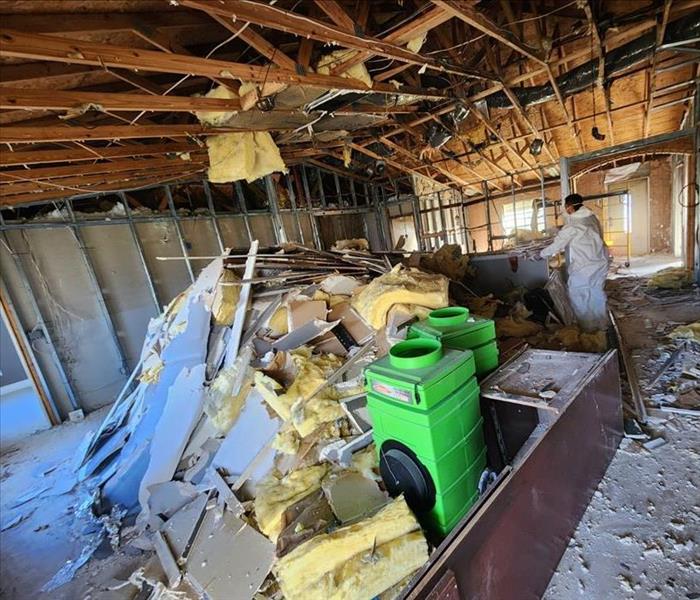Dehumidifiers and Mold Prevention: What You Need to Know
3/13/2024 (Permalink)
 In this blog, we will explore the role of dehumidifiers in mold prevention and provide essential information on using dehumidifiers to combat mold.
In this blog, we will explore the role of dehumidifiers in mold prevention and provide essential information on using dehumidifiers to combat mold.
Moisture control is crucial in preventing mold growth in your home. One effective tool for maintaining optimal humidity levels is a dehumidifier. In this blog, we will explore the role of dehumidifiers in mold prevention and provide essential information on using dehumidifiers to combat mold.
Understanding Dehumidifiers for Mold Prevention
Dehumidifiers are devices designed to reduce and maintain humidity levels in indoor spaces. They extract excess moisture from the air, helping to create a drier environment that is less conducive to mold growth.
Here are some key benefits of using dehumidifiers for mold prevention:
- Moisture Reduction: Mold requires moisture to grow, and high humidity levels can create an ideal environment for mold spores to thrive. Dehumidifiers help control humidity levels, keeping them below 50 percent, which inhibits mold growth.
- Prevention in High-Moisture Areas: Damp areas such as basements, bathrooms, and laundry rooms are prone to mold growth due to increased moisture. By using dehumidifiers in these areas, you can effectively manage humidity levels and reduce the risk of mold infestation.
- Protection for Vulnerable Items: High humidity can damage sensitive belongings like books, photographs, and wooden furniture. Dehumidifiers help protect these items by removing excess moisture from the air, preventing mold growth and preserving their condition.
Choosing the Right Dehumidifier
When selecting a dehumidifier for mold prevention, consider the size of your space, the humidity levels, and the extent of the moisture problem. Here are some key factors to keep in mind:
- Capacity: Consider the pint capacity, which refers to the amount of moisture a dehumidifier can remove from the air in 24 hours. Larger spaces or areas with high humidity will require a higher capacity dehumidifier to effectively manage moisture levels.
- Portability and Placement: Choose a dehumidifier that can be easily moved and positioned in different areas of your home. Portable units with caster wheels or handles offer convenience and flexibility.
- Noise Level: If you plan to use the dehumidifier in a living area or bedroom, consider the noise level. Look for models specifically designed to operate quietly, ensuring minimal disturbance to your daily activities.
- Energy Efficiency: Energy-efficient dehumidifiers consume less electricity, helping you save on your energy bills. Look for models with ENERGY STAR certification, which indicates optimal energy efficiency.
Complementary Mold Prevention Measures
While dehumidifiers play a vital role in mold prevention, they are most effective when combined with other preventive measures. Here are some additional steps to enhance mold prevention efforts:
- Ventilation: Proper ventilation reduces humidity levels, allowing moisture to escape your home. Ensure adequate ventilation in bathrooms, kitchens, and laundry areas to expel excess moisture.
- Fix Leaks and Moisture Sources: Promptly repair any leaks, plumbing issues, or roof leaks to eliminate ongoing sources of moisture.
- Use Exhaust Fans: Install and use exhaust fans in bathrooms and kitchens to remove excess moisture generated during activities like showering or cooking.
- Insulate and Seal: Properly insulate and seal windows, doors, and other areas where condensation can occur, preventing moisture buildup.
Dehumidifiers are effective tools in mold prevention, helping to maintain optimal humidity levels and create an environment that is unfavorable for mold growth. When selecting a dehumidifier, consider your specific needs and choose a model that suits the size and moisture levels of your space. Remember, using a dehumidifier is only one part of a comprehensive mold prevention strategy, and it is important to address any underlying moisture issues and implement additional preventive measures.
For professional assistance with mold prevention, remediation, and restoration, consider contacting experts such as SERVPRO® who specialize in mold restoration services. Their knowledge and expertise ensure that your home is protected from mold and its potential damage, providing you with a safe and healthy living environment.




 24/7 Emergency Service
24/7 Emergency Service